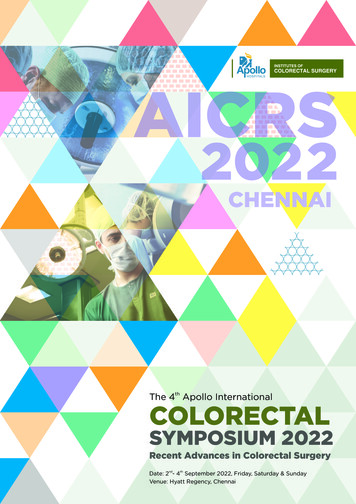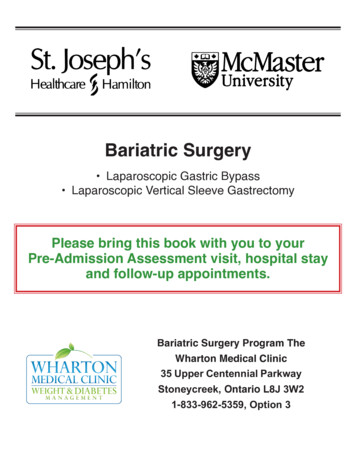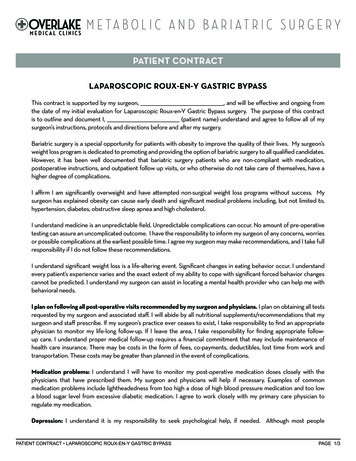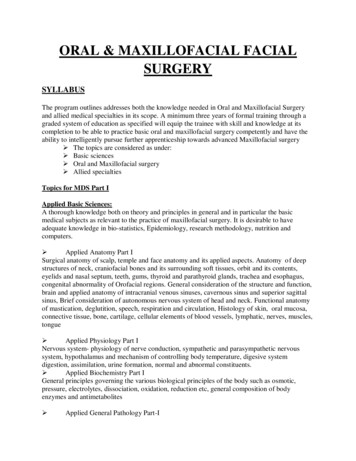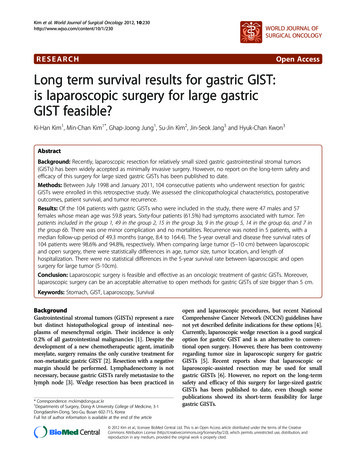
Transcription
Principles of Laparoscopic Surgery
EDITORSMaurice E. ArreguiRobert J. Fitzgibbons, Jr.Namir KatkhoudaJ. Barry McKernanHarry ReichWith Foreword byLawrence W. Way
Principles ofLaparoscopic SurgeryBasic and Advanced TechniquesWith 688 Illustrations in 762 Parts, 113 in Full ColorSpringer-VerlagNew York Berlin Heidelberg London ParisTokyo Hong Kong Barcelona Budapest
Maurice E. Arregui, M.D.Director, Fellowship in Laparoscopy, Endoscopy, and Ultrasound, St. Vincent Hospitalsand Health Center, Indianapolis, Indiana, USARobert J. Fitzgibbons, Jr., M.D.Professor of Surgery, Chief of General Surgery, Creighton University, Omaha, Nebraska,USANamir Katkhouda, M.D.Associate Professor of Surgery, Chief, Division of Outpatient and Minimally InvasiveSurgery, Director, Minimally Invasive Surgery Program and Center, University ofSouthern California, Los Angeles, California, USAJ. Barry McKernan, M.D., Ph.D.Clinical Professor of Surgery, Medical College of Georgia, Augusta, Georgia; ClinicalProfessor of Surgery, Emory University School of Medicine, Atlanta, Georgia; MariettaSurgery Center, Marietta, Georgia, USAHarry Reich, M.D.Advanced Laparoscopic Consultant, Wyoming Valley Health Care System, Wilkes-Barre,Pennsylvania; New York Center for Gynecologic Laparoscopic Surgery, New Rochelle,New York, USALibrary of Congress Cataloging-in-Pnblication DataPrinciples of laparoscopic surgery: basic and advanced techniques 1[edited by] Maurice E. Arregui. " let al.].p. cm.Includes bibliographical references and index.ISBN-13: 978-1-4612-7555-8DOl: 10.1007/978-1-4612-2480-8e-ISBN-13: 978-1-4612-2480-8I. Arregui, Maurice E., 1951[DNLM: 1. Surgery, Laparoscopic-methods.RD33.53.P75 1995617' .05-dc20DNLM/DLCfor Library of CongressWO 500 P569 1995]94-22505Printed on acid-free paper. 1995 Springer-Verlag New York Inc.Softcover reprint of the hardcover I st edition 1995All rights reserved. This work may not be translated or copied in whole or in part without the writtenpermission of the publisher (Springer-Verlag New York, Inc., 175 Fifth Avenue, New York, NY 10010,USA), except for brief excerpts in connection with reviews or scholarly analysis. Use in connection withany form of information storage and retrieval, electronic adaptation, computer software, or by similaror dissimilar methodology now known or hereafter developed is forbidden.The use of general descriptive names, trade names, trademarks, etc., in this publication, even if theformer are not especially identified, is not to be taken as a sign that such names, as understood by theTrade Marks and Merchandise Marks Act, may accordingly be used freely by anyone.While the advice and information in this book is believed to be true and accurate at the date of goingto press, neither the authors nor the editors nor the publisher can accept any legal responsibility for anyerrors or omissions that may be made. The publisher makes no warranty, express or implied, with respectto the material contained herein.Production coordinated by Impressions Publishing Services and managed by Laura Carlson; manufacturing supervised by Jacqui Ashri.Typeset by Impressions, a division of Edwards Brothers, Inc., Madison, WI.9 8 7 6 5 432 1
ForewordIn the five years since laparoscopic methods have gained widespread use in generalsurgery, a wealth of experience has accumulated. The surgical pioneers who recognized the potential value of laparoscopy for treatment many years previouslycertainly deserve a great deal of credit for their farsightedness. In a sense, however,the changes of the past few years amount to the development of a whole new branchof surgery. The rate of change has produced an intense demand for the surgicalcommunity to gather, structure, and disseminate the newly acquired knowledge.The safety and efficacy of this enormous shift in surgical practice hinges on thisprocess.In Principles of Laparoscopic Surgery, the editors have asked a select group ofexpert surgeons to present what amounts to an encyclopedic account of currentlaparoscopic surgical practice. The detailed but varying opinions on the management of gallbladder and complex pancreaticobiliary disease are unique to this volume. Not only are varying surgical viewpoints presented, but gastroenterologistsand radiologists also describe alternative methods of management. Because laparoscopic cholecystectomy is the most developed and most common procedure,Chapters 11 and 12 give an especially detailed overview, including clinical data tosupport each author's views. The editors have also included information from related fields in evolution, including minimally invasive urology, gynecology, and vascular and cardiovascular surgery. Aiming to be comprehensive, the coverage includes advances as well as basic instrumentation and techniques. Potentialcomplications are described to help surgeons avoid the pitfalls that lead to complications. The new scientific information concerning electrocautery, fiberoptics, therod-lens system, video cameras, lasers, and shock wave technology is presented indetail.Thus, this reference book thoroughly covers the indications, technique, and results of surgicallaparoscopy. It is a detailed, authoritative work that should be ofgreat use to both the novice and advanced laparoscopic surgeon.January 1995San Francisco, CaliforniaM.D.Professor of SurgeryUniversity of CaliforniaLAWRENCE W. WAY,v
PrefaceLaparoscopic cholecystectomy is today's gold standard for managing symptomaticcholelithiasis. This technique represents a milestone in the management of a common surgical disease. Globally, millions of patients have benefited. More importantly, however, it symbolizes a change in the mindset of general surgeons from thatof traditional followers to that of innovative thinkers willing to take the challengeof progress in a field of medicine which had grown staid. This redemption of thoughtand spirit represents the renaissance of general surgery which has created a newessence for progress that has spread like wildfire throughout the world to includenot only wealthy industrialized societies, but also encompassing less advantagedcountries with limited economic reserve. This new raison d'etre has inspired theapplications of minimally invasive surgery to other organs and disease processes,creating an avalanche of ideas and techniques designed to correct or amelioratesurgical diseases in a more humane manner.Thousands of surgeons internationally have taken courses and precepted to learnlaparoscopic methods. Numerous textbooks, journals, newsletters, videotapes, andnow CD-ROMs have been produced to provide the information surgeons thirst for.To date, most of these textbooks have been written in "cookbook" fashion providing a step-by-step description of "how I do it." Because most of these early textbooks have been written at a time when little clinical data had accumulated andonly few surgeons had significant experience, they were appropriate. Unlike theseearlier books, Principles of Laparoscopic Surgery is a complete textbook on basicand advanced techniques in minimally invasive surgery. This textbook not onlydescribes the techniques used, but it presents the rationale for their use and clinicalmaterial to support it. Because minimally invasive techniques have truly been developed in a worldwide arena, internationally renown experts have been invited tocontribute. Moreover, because minimally invasive techniques are used in variousspecialties, innovators in vascular surgery, cardiology, radiology, urology, and gynecology have been asked to share their ideas and experiences. Laparoscopic cholecystectomy and laparoscopic common bile duct explorations exemplify our borrowing equipment developed for gynecologic and urologic purposes, and adaptedto general surgical problems. Likewise, knowledge of techniques and technologydeveloped in other fields may find application in other problems faced by the general surgeon or other specialists working with minimally invasive approaches.Section I provides essential information on equipment and basic techniques.Nursing and anesthetic considerations are covered in detail. Credentialling, trainingconcepts and guidelines are developed. In Section II, the various organ systems areapproached with minimally invasive techniques that include not only different laparoscopic approaches, but also the options of endoscopic and radiologic approacheswhich are presented by both surgical and nonsurgical colleagues. These variousalternative techniques are described by experts who defend their rationale withextensive clinical data. These approaches are also compared with the traditionalvii
PrefaceVlllopen methods to try to place the newer techniques in perspective. Section III looksat the important developments in the specialty areas, with an extensive look intogynecology and urology. Angioscopy in venous and arterial intraluminal surgeryprovides a window to potential developments that may find applications in abdominal surgery. Three-dimensional ultrasound reconstruction of arterial plaques provide a titillating preview of an exciting new imaging modality. Section IV dealsextensively with the technology presently being used and provides an insight intopotentially useful future technology. The surgeon will have the opportunity to betterunderstand the mechanisms of tissue ablation with laser and electrocautery, thedynamics of stone destruction with electrohydraulic and shock wave lithotripsy, aswell as the physics of light and image transmission necessary to couple intraperitoneal images to the video screen.The editors hope that this textbook will provide the surgeon with the techniques,and clinical and scientific information necessary to advance his or her skills in thismodern era of surgery.Maurice E. Arregui
ContentsForeword .vPreface .VllContributors .XVllSection I. Basic Laparoscopic Techniques.11. A History of Endoscopic Surgery .Chad 1. Davis and Charles 1. Filipi32. Basic Equipment and Instrumentation .Harry Reich and 1. Barry McKernan213. Electrosurgery Techniques of Cutting and Coagulation.Mohan C. Airan and Sung-Tao Ko304. Suturing Techniques.Henry L. Laws355. Current Concepts in Operative Surgery Using Video endoscopicallyAssisted Mechanical-Suture Techniques.Felicien M. Steichen, Roger Welter, Hee Yang, Edward B. Sottile, andVito A. Marrero466. Sterilization and Disinfection of Laparoscopic Equipment .David W. Duppler667. Complications of Laparoscopic SurgeryAvram M. Cooperman718. Anesthesia .788.1. Anesthetic Implications of Laparoscopy, Thoracoscopy, andHysteroscopy .Martin B. Wehlage798.2. Local Anesthesia in LaparoscopyBarry A. Salky87IX
xContents9. The Team: Nursing's Perspective .Nissa Partain De Lisle, Karen Denise Jackson, Vangie Paschall, andKevin Wagner9110. Teaching, Credentialling, and Privileging .Theodore R. Schrock and Thomas L. Dent101Section II. Laparoscopy and Thoracoscopy in General Snrgery .10711. Biliary Tract Disease .10911.1. The Development of Laparoscopic Cholecystectomy and ItsImpact .Jacques Perissat11011.2. Laparoscopic Cholecystectomy .David E. Pitcher, Daniel T. Martin, and Karl A. Zucker11311.3. Intraoperative Cholangiography-Routine .Jonathan M. Sackier12911.4. Selective Cholangiography .Mark A. Talamini13911.5. Laparoscopic Ultrasound of the Biliary Tree .M.A. Rothlin14311.6. Percutaneous Management of Gallbladder StonesSarah Cheslyn-Curtis and R. C. G. Russell15011.7. Ablation of the Gallbladder Mucosa .Robert C. Hall15911.8. Complications of the Biliary Tract . . . .Gene D. Branum and William C. Meyers16412. Management of Common Bile Duct Stones.17112.1. The Evolution of Common Bile Duct (CBD) Stone Removal.George Berci17212.2. The Evolving Role of ERCP in the Era of LaparoscopicCholecystectomy .Jorge Navarrete, Joel C. Hammond, and Maurice E. Arregui17512.3. Intraoperative Endoscopic Retrograde Cholangiopancreatography(ERCP) .Aurea Ludovico de Paula, Kiyoshi Hashiba, and Mauro Bafutto18512.4. Laparoscopic Management of Common Bile Duct Calculi.Edward H. Phillips12.5. Laparoscopic Choledochotomy for Management of Common BileDuct Stones and Other Common Bile Duct Diseases .Morris E. Franklin, Jr.191197
ContentsXl12.6. Fluoroscopic Transcystic Common Bile Duct Exploration inLaparoscopic Cholecystectomy .Brock M. Bordelon and John G. Hunter20512.7. Electrohydraulic Lithotripsy of Common Bile Duct Stones . ,. .Osman Yucel and Maurice E. Arregui21112.8. Biliary Laser Lithotripsy.Desmond H. Birkett21712.9. Extracorporeal Shock Wave Lithotripsy in the Management ofCommon Bile Duct Stones.Frederic E. Eckhauser and Steven E. Raper22212.10. Radiologic Management of Biliary Stone Disease .Eric vanSonnenberg, Gerhard R. Wittich, Oliver Esch, Eric M.Walser, and Robert Morgan22713. Laparoscopic Antireflux Surgery .23113.1. Laparoscopic Nissen Fundoplication for Gastroesophageal RefluxDisease.Charles J. Filipi, Ronald A. Hinder, and Robert J. Fitzgibbons, Jr.23213.2. Laparoscopic Rossetti Fundoplication for Treatment ofGastroesophageal Reflux .Namir Katkhouda and Jean Mouiel24314. Laparoscopic Surgery of the Stomach .24714.1. Principles of Peptic Ulcer Surgery .Namir Katkhouda, Johannes Heimbucher, and Jean Mouiel24814.2. Laparoscopic Vagotomies for Elective Treatment of Peptic UlcerDisease.Namir Katkhouda and Jean Mouiel14.3. Treatment of Complications of Peptic UlcersNamir Katkhouda and Jean Mouiel25226015. Laparoscopic Appendectomy .Brian C. Organ26816. Laparoscopic Small-Bowel Surgery .Daniel T. Martin, David E. Pitcher, and Karl A. Zucker27817. Laparoscopic Surgery for Adhesiolysis .Harry Reich28318. Colon and Rectum .29918.1. Laparoscopic Surgery of the Colon and Rectum .Morris E. Franklin, Jr.300
ContentsXlI18.2. Rectal Lesions .G. Buess and U. Weiss30919. Laparoscopic Staging of Malignancies .Frederick L. Greene31820. Management of Pancreatic Disease32420.1. Laparoscopic Management of Pancreatic Disease .D. Litwin and L. Rossi32520.2. Endoscopic Therapy of Benign Pancreatic DiseaseGregory B. Haber and Isaac Raijman33221. Laparoscopic Surgery of the Liver.Namir Katkhouda and Jean Mouiel34522. Laparoscopic Splenectomy .Stephen Wise Unger and Gary J. Rosenbaum35623. Laparoscopic Adrenalectomy .L. Michael Brunt and Nathaniel J. Soper36624. The Use of Laparoscopy in Trauma . . . . .Chris Salvino, Greg Pulawski, and Peter Geis37925. Laparoscopic Hernia .39925.1. Laparoscopic Inguinal Herniorrhaphy: Current Techniques.Jose Camps, Nam Nguyen, Riccardo Annibali, Charles J. Filipi, andRobert J. Fitzgibbons, Jr.40025.2. Anatomical Considerations for Laparoscopic InguinalHerniorrhaphy .Riccardo Annibali, Jose Camps, Robert F. Nagan, Thomas H. Quinn,Maurice E. Arregui, and Robert J. Fitzgibbons, Jr.40925.3. Prosthetic Materials and Adhesion Formation . . . .Riccardo Annibali, Jose Camps, Nam Nguyen, and Robert J.Fitzgibbons, Jr.42625.4. Avoiding Complications of Laparoscopic Hernia Repair .Namir Katkhouda43525.5. Prevention of Complications of Open and Laparoscopic Repair ofGroin Hernias .Cihat Tetik and Maurice E. Arregui43926. Pediatric Laparoscopy .45026.1. Principles of Pediatric Laparoscopy .Joseph S. Sanfilippo and Thom E. Lobe45126.2. Principles of Nonacute Pediatric Laparoscopy .J.S. Valla and J.L. Alain474
Contentsxiii27. Laparoscopic Ultrasound: Principles and Techniques .Daniel Castro, Maurice E. Arregui, and Armin Brueggemann48928. Surgical Endoscopy .50628.1. Combined Use of Flexible Gastrointestinal Endoscopy andLaparoscopy .Frederick L. Greene50728.2. Endoscopic Retrograde Cholangiopancreatography in SurgicalPractice: An Overview.Jeffrey L. Ponsky51229. Modern Thoracoscopy. . . . . . . . . . . .B.M. Rodgers, J.K. Champion, and J. C. Wain517Section UI. Laparoscopy in Subspecialties .53530. Gynecology .53730.1. The Laparoscopic Management of Endometriosis for the Relief ofPain .Gordon Davis53830.2. Pelvic Pain Syndromes: Endometriosis and Midline Dysmenorrhea.David B. Redwine and James J. Perez54530.3. Laparoscopically Assisted Reproductive Technique .Jose P. Balmaceda and Alejandro Manzur55930.4. Laparoscopic Ovarian Surgery .Harry Reich and William H. Parker56630.5. Ectopic Pregnancy. .Harry Reich and Nicholas Kadar57830.6. Laparoscopic Treatment of Tubo-Ovarian and Pelvic Abscess.Harry Reich59530.7. Hysteroscopic Surgery .Ray Garry60530.8. Laparoscopic Hysterectomy .Harry Reich61330.9. Operations on the UterusK. Semm and I. Semm62630.10. The Role of Laparoscopy in the Surgical Treatment of Pelvic-FloorRelaxation .Thierry G. Vancaillie30.11. Laparoscopic Treatment of Urinary Stress IncontinenceC. Y. Liu633640
xivContents30.12. Laparoscopic Management of Vaginal Aplasia with or WithoutFunctional Noncommunicating Rudimentary Uterus .Leila V. Adamyan64630.13. Laparoscopic Management of Gynecologic MalignanciesNicholas Kadar65230.14. Laparoscopic Para-Aortic LymphadenectomyJoel M. Childers67231. Urology .68031.1. Urinary Tract Stones . . . . . . . . . . .Gary C. Bellman and Arthur D. Smith68131.2. Laparoscopic Varicocele Ligation .Greg 0. Lund, James F. Donovan, Jr., and Howard N. Winfield68731.3. Laparoscopic Nephrectomy .Kevin R. Anderson and Ralph V. Clayman69331.4. Laparoscopic Pelvic Lymphadenectomy to Diagnose MetastaticProstate Cancer .Richard W. Graham and Nada L. Wood70231.5. Techniques of Combined Intracavity Endoscopic and LaparoscopicTherapy.Graham Watson71232. Angioscopy.71732.1. Operative Angioscopy .Malcolm B. Herring71832.2. Endoscopic Techniques for Percutaneous Transluminal CoronaryProcedures: Intravascular Ultrasound and Angioscopy .Zachary 1. Hodes and Thomas J. Linnemeier722Section IV. Technological Aspects of LaparoscopylHigh Technology .72933. Physics of Tissue Ablation . . . . . .73133.1. Electrosurgery in Laparoscopy .Roger C. Odell73233.2. Laser Physics and the Physics of Tissue Ablation . . .Gregory R. McArthur74033.3. Ultrasonic Dissection .John H. Payne, Jr.74934. Physics of Stone Fragmentation.75734.1. The Principles of Electrohydraulic Lithotripsy.Desmond H. Birkett758
Contentsxv34.2. The Physics of Laser Stone Fragmentation.Graham Watson76034.3. The Physics of Extracorporeal Shock Wave Lithotripsy in StoneFragmentation .Steven E. Raper and Frederic E. Eckhauser76435. Visualization . . . . . . . .76635.1. The Hopkins Rod-Lens System .Sarah Cheslyn-Curtis and Harold H. Hopkins76735.2. Fiberoptic Endoscopy .Joseph R. Williams77135.3. How the Medical Video Camera Became the Surgeon's Tool. . .William Chang77735.4. Light Sources for Endoscopic Procedures.William Chang78535.5. Photodocumentation: Video-Based Digital Photographs and VideoImaging During the Laparoscopic Procedure .S. Jan Morgan78936. Roentgenologic Imaging of the Biliary System During LaparoscopicCholecystectomy .John G. Hunter79537. Use of Intraoperative Ultrasound in Laparoscopic Liver Surgery.D. Castaing, M. Johann, and K. Ahchong80338. Future Developments .80638.1. Retrieval Systems in Minimally Invasive Surgery .David Rosin80738.2. Stereoscopic Imaging for Laparoscopy .David Southgate81138.3. Interactive Computer Training .Aly Sabri81838.4. Computer Simulation Training Devices.Mark D. Noar82238.5. Virtual Reality and SurgeryRichard M. Satava83438.6. Surgical Robotics .Michael R. Treat837Index .845
ContributorsLEILA V. ADAMYAN, Doctor Medical Sciences, Professor, Head of Operative Gynecology Department, Moscow, RussiaK. AHCHONG, University of Paris School of Medicine, Hospital Paul Brousse, Villejuif, FranceMOHAN C. AIRAN, M.D., Clinical Professor of Surgery, Chicago Medical School,Associate Chairman of Surgery, Mount Sinai Hospital Medical Center, Westchester,IL, USAJ.L. ALAIN, M.D., Professor of Surgery, Chief, Department of Pediatric Surgery,University of Limoges School of Medicine, Limoges, FranceKEVIN R. ANDERSON, M.D., Section of Urology, Yale University School of Medicine, New Haven, CT, USARICCARDO ANNIBALI, M.D., Divisone di Chirurgia I, Ospedale "Valduce," Como,ItalyMAURICE E. ARREGUI, M.D., Director of Fellowship in Laparoscopy, Endoscopy,and Ultrasound, St. Vincent Hospitals and Health Center, Indianapolis, IN, USAMAURO BAFUTTO, M.D., Director, Department of Gastroenterology, Hospital Samaritano, Goiania-Goias, BrazilJOSE P. BALMACEDA, M.D., Professor and Director of Reproductive Endocrinology and Infertility, Department of Obstetrics and Gynecology, University of California at Irvine, Laguna Hills, CA, USAGARY C. BELLMAN, M.D., Attending Urologist and Director, Regional KidneyStone Center, Kaiser Permanente, Los Angeles, CA, USAGEORGE BERCI, M.D., Director of Research and Education, Endocare Center,Midway Hospital Medical Plaza, Los Angeles, CA, USADESMOND H. BIRKETT, M.D., Department of Surgery, University Hospital, Boston,MA, USABROCK M. BORDELON, M.D., Chief Resident, General Surgery, University of UtahSchool of Medicine, Salt Lake City, UT, USAXVll
xviiiGENE D. BRANUM, M.D., Emory University School of Medicine, Atlanta, GA,USAARMIN BRUEGGEMANN, M.D., Department of Surgery, University of G6ettingen,G6ettingen, GermanyL. MICHAEL BRUNT, M.D., Assistant Professor of Surgery, Washington UniversitySchool of Medicine, The Jewish Hospital of St. Louis, St. Louis, MO, USAG. BUESS, M.D., Professor of Surgery, Chief, Unit of Minimal Invasive Surgery,University of Tiibingen School of Medicine, Klinikum Scharrenberg, Tiibingen,GermanyJOSE CAMPS, M.D., Laparoscopic Surgery Research Fellow, Department of Surgery, Creighton University School of Medicine, Omaha, NE, USAD. CASTAING, M.D., Professor of Surgery, University of Paris School of Medicine,Hospital Paul Brousse, Villejuif, FranceDANIEL CASTRO, M.D., Bogota, ColombiaJ.K. CHAMPION, M.D., Clinical Professor of Surgery, Mercer University School ofMedicine, Macon, GA; Director of Endosurgical Education, Emory EndosurgicalCenter, Emory University School of Medicine, Atlanta, GA; Emory University Hospital, Department of Surgery, Atlanta, GA, USAWILLIAM CHANG, Vice President, Research and Development, Stryker Endoscopy,San Jose, CA, USASARAH CHESLYN-CURTIS, M.S., F.RC.S., The Luton and Dunstable Hospital, NHSTrust, Luton, UKJOEL M. CHILDERS, M.D., Department of Obstetrics and Gynecology, Division ofGynecologic Oncology, University of Arizona College of Medicine, Tucson, AZ,USARALPH V. CLAYMAN, M.D., Professor of Urologic Surgery/Radiology, WashingtonUniversity School of Medicine, St. Louis, MO, USAAVRAM M. COOPERMAN, M.D., Professor of Surgery, New York Medical College,Valhalla, NY; Codirector, The Laparoscopic Institute for Surgery, Dobbs FerryCommunity Hospital, Dobbs Ferry, NY, USACHAD J. DAVIS, M.D., Department of Surgery, St. Vincent Hospitals and HealthCenter, Indianapolis, IN, USAGORDON DAVIS, M.D., Phoenix, AZ, USANISSA PARTAIN DE LISLE, D.S.N., RN., C.N.O.R, Powder Springs, GA, USAAUREO LUDOVICO DE PAULA, M.D., Director of Surgical Laparoscopy and Endoscopy, Department of Surgery, Hospital Samaritano, Goiania-Goias, BrazilContributors
ContributorsXIXTHOMAS L. DENT, M.D., Professor of Surgery, Temple University School of Medicine, Philadelphia, PA; Chairman, Department of Surgery, Abington MemorialHospital, Abington, P A, USAJAMES F. DONOVAN, JR., M.D., Department of Urology, University of Iowa Collegeof Medicine, Iowa City, lA, USADAVID W. DUPPLER, M.D., Fox Valley Surgical Associates, Appleton, WI, USAFREDERIC E. ECKHAUSER, M.D., Division of Gastrointestinal Surgery, Departmentof Surgery, University of Michigan Medical Center, Ann Arbor, MI, USAOLIVER ESCH, M.D., Department of Radiology, University of Texas MedicalBranch, Galveston, TX, USACHARLES J. FILIPI, M.D., Assistant Professor of Surgery, Creighton University,Omaha, NE, USAROBERT J. FITZGIBBONS, JR., M.D., Professor of Surgery, Creighton University,Omaha, NE, USAMORRIS E. FRANKLIN, JR., M.D., Clinical Professor of Surgery, University of TexasHealth and Science Center, San Antonio, TX, USARAY GARRY, M.D., South Cleveland Hospital, Middlesbrough, Cleveland, UKPETER GElS, M.D., Director of Minimally Invasive Surgical Training, Chief of Minimally Invasive Surgery, St. Joseph's Hospital, Talson, MD, USARICHARD W. GRAHAM, M.D., The Urology Center, Richmond, VA, USAFREDERICK L. GREENE, M.D., Professor of Surgery, Director
only few surgeons had significant experience, they were appropriate. Unlike these earlier books, Principles of Laparoscopic Surgery is a complete textbook on basic and advanced techniques in minimally invasive surgery. This textbook not only describes the techniques used, but it presents the rationale for their use and clinical



